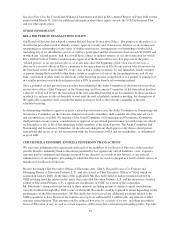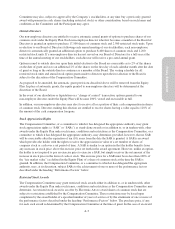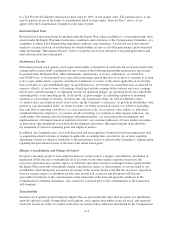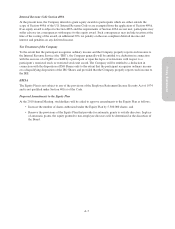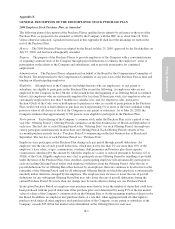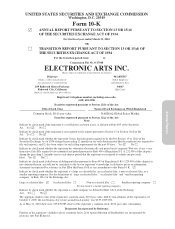Electronic Arts 2010 Annual Report Download - page 69
Download and view the complete annual report
Please find page 69 of the 2010 Electronic Arts annual report below. You can navigate through the pages in the report by either clicking on the pages listed below, or by using the keyword search tool below to find specific information within the annual report.
Proxy Statement
Committee and except that nonqualified stock options may be transferred to family members and trusts or
foundations controlled by, or primarily benefiting, family members of the optionee.
Term of the Equity Plan
The Equity Plan expires in 2020 unless terminated earlier by the Board.
United States Federal Income Tax Information
THE FOLLOWING IS A GENERAL SUMMARY AS OF THE DATE OF THIS PROXY STATEMENT OF
THE UNITED STATES FEDERAL INCOME TAX CONSEQUENCES TO THE COMPANY AND
PARTICIPANTS UNDER THE EQUITY PLAN. THE FEDERAL TAX LAWS MAY CHANGE AND THE
FEDERAL, STATE AND LOCAL TAX CONSEQUENCES FOR ANY PARTICIPANT WILL DEPEND
UPON HIS OR HER INDIVIDUAL CIRCUMSTANCES. IN ADDITION, THE INTERNAL REVENUE
SERVICE COULD, AT ANY TIME, TAKE A POSITION CONTRARY TO THE INFORMATION
DESCRIBED IN THE FOLLOWING SUMMARY. ANY TAX EFFECTS THAT ACCRUE TO NON-U.S.
PARTICIPANTS AS A RESULT OF PARTICIPATING IN THE EQUITY PLAN ARE GOVERNED BY THE
TAX LAWS OF THE COUNTRIES IN WHICH SUCH PARTICIPANT RESIDES OR IS OTHERWISE
SUBJECT. EACH PARTICIPANT WILL BE ENCOURAGED TO SEEK THE ADVICE OF A QUALIFIED
TAX ADVISOR REGARDING THE TAX CONSEQUENCES OF PARTICIPATION IN THE EQUITY PLAN.
Incentive Stock Options
A participant will recognize no income upon grant or vesting of an incentive stock option and will generally not
incur tax on its exercise. Unless the participant is subject to the alternative minimum tax (“AMT”), the
participant will recognize income only when the shares acquired upon the exercise of an incentive stock option
(the “ISO Shares”) are sold or otherwise disposed of. If the participant holds ISO Shares for more than one year
after the date the option was exercised and for more than two years after the date the option was granted, the
participant will realize a long-term capital gain or loss (rather than ordinary income) upon disposition of the ISO
Shares. This long-term capital gain or loss will be equal to the difference between the amount realized upon such
disposition and the amount paid for the ISO Shares.
If the participant disposes of ISO Shares prior to the expiration of either the one-year or two-year required
holding period (a “disqualifying disposition”), the gain realized upon such disposition, up to the difference
between the fair market value of the ISO Shares on the date of exercise (or, if less, the amount realized on a sale
of such shares) and the option exercise price, will be treated as ordinary income. Any additional gain will be
capital gain, taxed at a rate that depends upon the amount of time the ISO Shares were held by the participant.
Alternative Minimum Tax
The Alternative Minimum Tax (“AMT”) is a separately computed tax which was devised to ensure that at least a
minimum amount of income tax is paid. AMT is imposed only if and to the extent that a participant would pay
more tax if his or her income tax were calculated pursuant to the AMT rules than if calculated in the regular
manner. The difference between the option exercise price and the fair market value of the ISO Shares on the date
of exercise is includable as income for purposes of calculating the AMT for both (i) a vested ISO and (ii) an
unvested ISO for which the participant makes a timely election under Section 83(b) of the U.S. Internal Revenue
Code (an “83(b) election”).
Alternative minimum taxable income is determined by adjusting regular taxable income for certain items,
increasing that income by certain tax preference items (including the difference between the fair market value of
the ISO Shares on the date of exercise and the exercise price) and reducing this amount by the applicable
exemption amount. The exemption amount for 2009 is $70,950 in the case of a joint return, subject to reduction
under certain circumstances. The AMT (imposed to the extent it exceeds the taxpayer’s regular income tax) is
26% of an individual taxpayer’s alternative minimum taxable income (28% in the case of alternative minimum
taxable income in excess of $175,000 in the case of married individuals filing a joint return). If a disqualifying
disposition of the ISO Shares occurs in the same calendar year as the exercise of an incentive stock option, those
ISO Shares are not included in the AMT calculation.
A-5



